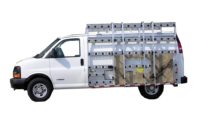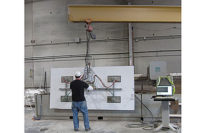As consumers continue to evolve with their wants and needs, so does the material handling industry. From larger countertops to more custom and innovative designs, it is a constant challenge for stone fabricators to keep their products and tools relevant and useful.
Regardless of how consumers, preferences and technology shape the industry, one thing is certain; safety in handling and transportation of products will always be a top priority. To promote safety, many products continue to evolve and improve safety features. Enhanced load capacities, user-friendly sling and strap mechanisms, and strategically placed safety posts are just a few examples that bring additional value to products in the marketplace, while putting fabricator safety first. In addition to product safety enhancements, safety training materials will become more readily available and easier to access. Online instructional and safety videos — covering a broad range of topics — are now at the fingertips of end-users within seconds. The appeal, simplicity and engaging nature of these resources will continue to evolve, however, they will undoubtedly reinforce critical concepts and safety standards in the industry.
In addition to continued product enhancements and more engaging and readily available safety information, an underlying opportunity may exist to not only promote the safety of fabricators, but to increase the overall productivity of an individual or company. By examining the process by which fabricators prepare, cut, store and transport products, it is possible to further embed safety standards and practices, while saving time and money.
Lean manufacturing isn’t a new concept. The practice and principles have been around for decades and are utilized in dozens of industries. With the overall idea being adding value to the customer while reducing wasted time and energy for the supplier/manufacturer, the lean toolbox is vast. What may surprise you is the relative ease by which these concepts can be applied. Here is one example: A mid-sized stone fabrication shop receives a truckload of slabs on the warehouse dock. From there, the individual slabs are unloaded and stored toward the back of the warehouse in a bundle rail system awaiting further inspection. In preparation for cutting, a slab is moved across the warehouse on a shop cart to another bundle rail system and then eventually onto the table for template layout and cutting. Once cut to the desired size, the stone is moved to another part of the shop for fabricating and polishing. Finally, after a quality check, the finished pieces are moved again to be prepared for shipping or transportation to the jobsite.
In total, it is possible for a slab of stone to be physically moved around a shop the equivalent of a half mile or more. This movement and multiple staging points on various products increase the number of times the slab is touched, increasing the chance of damage to the product and the number of opportunities for safety issues to arise. This movement also results in time spent moving the slab rather than completing the tasks required to deliver it to the customer.
In addition to having the correct products to minimize the number of times the stone is handled and stored, fabrication shops may benefit from reviewing their process of moving and storing products from the time they arrive until the time they leave the shop. A simple, yet effective, lean tool to aid in this review is called a Spaghetti Diagram.
A Spaghetti Diagram:
- Results in a physical drawing of the work area
- Follows the product, in this case a slab of stone, from being received to being shipped or delivered
- Provides a visual depiction of the number of times and locations the slab is moved
As the name of the tool suggests, oftentimes the result is a map of the work area covered in many overlapping scribbles resembling a bowl of spaghetti. While your current process “works,” it may not truly be effective. This visual can be both enlightening and frustrating at the same time. However, when used properly, this tool — along with some of the additional lean tools designed to improve the process — can provide many positive results.
Even the smallest improvement in layout can positively impact the overall time a fabricator will spend preparing the product for the customer. These improvements will also help to reduce the number of chances the product will be damaged and the number of times a fabricator will be put in harm’s way during the process. As products continue to evolve and safety programs enhance the lives of those in the industry, it may be worth reviewing your process to ensure quality and efficiency are embedded in your shop.





